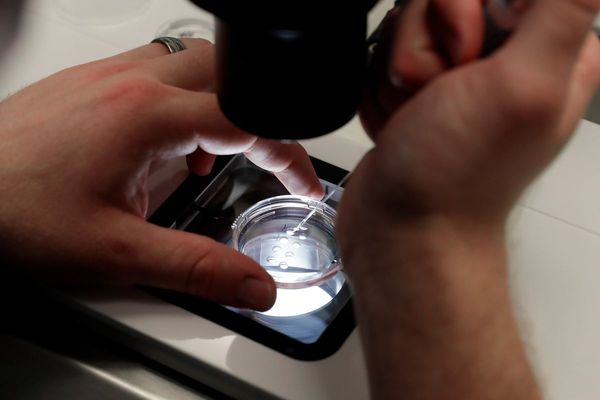
Pass a sharp spade through wet grass and into soggy mud. Turn 90 degrees to make a T and give it a waggle. Ease the bare roots into the slot and firm in with boot heel. One down, 1,199 to go.
The Blackdown Hills are veiled in murk and there’s no let-up in the steady drizzle, but the community farm volunteers have turned up in waterproofs and wellies, and are cheerfully getting stuck in. We have 230 metres of hedge to plant, and there’s no time to lose. It will take about five years until it resembles something like a hedge.
At 11am, we’re joined by 40 year 6 students from the local primary school. Some are on mulch duty and dive into the woodchip pile with glee. Others balefully eye the spades that are almost as tall as they are, while their mates charge off brandishing plastic tree guards like floppy lightsabers, hotly pursued by teachers. But still the zigzag tramline of trees grows, marching steadily down the slope.
It feels good to be outdoors on the cusp of spring, stitching a new hedge into the patchwork of fields. With the growth of industrial agriculture over the past 50 years, the UK has lost more than 118,000 miles of hedgerow – almost five times the circumference of the Earth. This shocking statistic is directly related to the catastrophic decline of our wildlife: 95% of hedgehogs, 93m wild birds.
Here on the town’s newly designated green corridor, we are attempting to reverse the trend, one small plant at a time. Hawthorn, blackthorn, field maple, guelder rose and hazel. On the other side of the green corridor, the Transition Town team are cutting and “laying” an old hedge that has been badly neglected. Using billhooks, they work slowly, chopping through stems until they can be hinged downwards and tied. It’s all baby steps – two forward and one back, to be honest, given the wider context of housing developments, supermarket car parks and the massive flailing machines that bash hedges into square-edged submission. But we’re not alone. With government incentives, many farmers are now working to restore hedgerows, seeing their vital role in boosting biodiversity, preventing floods, storing carbon and stabilising our precious topsoil.
A curious robin comes to inspect the earthworks; a wren trills madly somewhere among the brambles. Hopefully, in a year or two, they will have somewhere to nest and rest, forage and hide.
• Country diary is on Twitter at @gdncountrydiary







